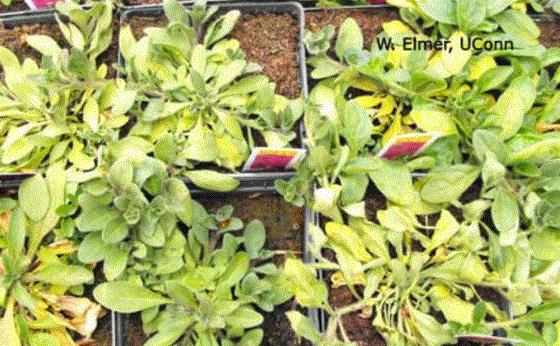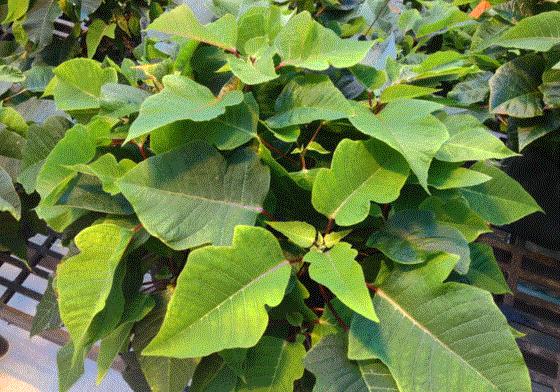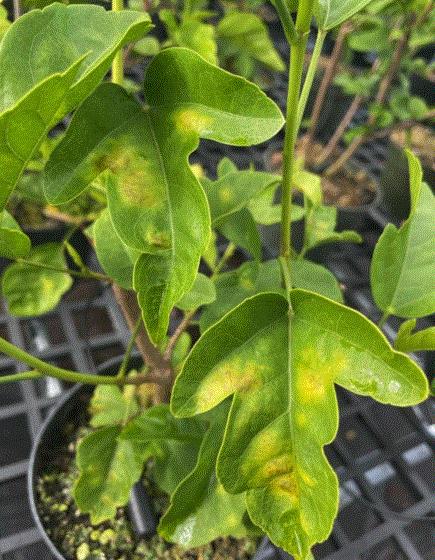Thielaviopsis Deep Dive
We’ve covered this particular pathogen any number of times in past editions of the Tech On Demand newsletter, sometimes citing new research or relating to timely challenges with specific crops. With a host range of more than 100 species, there really are not many crops that aren’t susceptible to Thielaviopsis—which also means you and your team need to be very familiar with prevention and management strategies. If you need a topic to cover in a production meeting leading into the 2024 spring season, this is a good one.
Pathologist and “friend of the newsletter” Dr. Ann Chase wrote about Thielaviopsis basicola, black root rot, in the current issue of GrowerTalks, and I want to call your attention to THE ARTICLE. As she states in the first paragraph, this pathogen commonly affects pansy, calibrachoa, vinca, salvia and petunia, while also being reported on cyclamen, fuchsia, gaillardia, gerbera, holly, snapdragon, geranium, phlox, poinsettia and more. That should get your attention, because I can 100% guarantee you grow some or many of these crops.

In the article, Anne runs through the symptoms and conditions that encourage the disease, along with management approaches, while also sharing results from recent fungicide studies attempting to determine and rank their relative effectiveness. You’ll need to read the full story for the specifics, but (spoiler alert) she does conclude, “The most consistently highly effective products are those containing thiophanate methyl (FRAC 1—Cleary 3336 and OHP 6672). It’s been tested more than any other active ingredient based on serving as the best control of black root rot for the past 25 years or longer.”
Summing up, Ann offers the following four steps as most-effective for preventing black root rot:
-
Never reuse flats or containers without sanitizing first
-
Maintain potting medium pH below 5.5
-
Use ammoniacal fertilizer and do not apply excessive potassium
-
Use a thiophanate methyl fungicide (OHP-6672 or Cleary 3336) first and then rotate with FRAC 3 (Avelyo or Terraguard) OR FRAC 19 (Affirm)

More Black Root Rot Resources
If you do plan to conduct some in-house training for team members, here are some more solid resources from leading university researchers that cover black root rot quite thoroughly, and with photos and control methods. Basically, you’re looking for stunting, yellowing and wilting up top and brown or black bands on plant roots. If you suspect Thielaviopsis, you definitely want to send plants in to be tested by a lab to be sure that’s the problem.

I’ve listed three resources below to bookmark or print out for your team. Now is a great the time to remind everyone to be on the lookout for the signs mentioned above before the season kicks into high gear—and do not let your guard down even for a few days! It’ll soon be “disease time” and you want to stop black root rot in its tracks and not risk taking losses in production.

Nick’s Tip of the Week: Curb Excessive Poinsettia Growth NOW!
Each week, I’ll work with my buddy Nick Flax, a technical services expert at Ball, to share a concern that’s come up during one of his numerous calls with growers across North America. This week, he’s been assisting growers with poinsettia crops in the final stages of production—especially those dealing with leggy plants.
PROBLEM: With a couple of weeks of short days under our belts and seven weeks to go until Thanksgiving, poinsettias are still filling out across North America. I’ve seen some excellent-looking crops the last couple of weeks, but some folks have struggled to keep their plants on track. In addition to calcium (Ca) deficiency issues (check out LAST WEEK’S TIP for more info), quite a few of your peers have reached out to me for help because their poinsettias have started to get too tall. In fact, several growers I’ve worked with to address Ca deficiency were also struggling to keep plants toned and compact.
Plant physiology pop quiz! Why might a poinsettia grower who encountered Ca deficiency also have leggy plants?

NICK’S TIP: Let’s take a look at factors that can lead to early stretching, and strategies to combat it before it’s too late.
What Causes Poinsettias to Stretch?
There are several factors that can cause poinsettias to balloon up and get leggy at this stage in the crop cycle. It’s easy to get into the weeds when it comes to plant physiology, so I like to put these factors into a few “buckets” to keep things simple:
Turgor. Commonly known as the “internal pressure of plant cells,” excessive turgor causes stem and leaf cells to expand rapidly. Turgor pressure can become excessive when plants are well-watered and relative humidity (RH) in the crop canopy is high, so the main lines of defense against this are:
-
Ensure that you establish thorough wet-to-dry cycles.
-
Space plants in a timely manner: when leaves of adjacent plants begin to overlap after pinch.
-
Maximize airflow through your crop, and dehumidify the greenhouse whenever possible if RH starts to exceed about 70%.
(Answer to the pop-quiz: Ca deficiency in poinsettias is most often caused by poor movement of water through plants due to excessively high RH and soggy soils. As such, those of you who battle Ca deficiency also often run into stretchy internodes due to high turgor that occurs under the same conditions.)
Shade avoidance. Remember that poinsettias are essentially a tropical shrub that we force to grow in cool, dark North American greenhouses from late summer through early winter. They don’t like the shade ... though plant breeders have done wonders to better acclimate this staple crop to cooler, darker conditions. Still, stretching can occur when light levels are too low. As such, be certain that your shade curtains are adjusted to stay open now that we’re into October, and rinse off that roof shading compound, especially if you put it on a little heavier this summer due to the extreme temperatures that many of us battled. Also, too-tight spacing can cause stretching due to competition for light—again, be sure to space plants in a timely manner, meaning after pinch, when the canopy tightens.
Wrong fertilizer. Like garden mums, which many of you have also grown this season, poinsettias are heavy feeders. However, they don’t require the same levels of phosphorous- and ammonia-form nitrogen that mums really need to thrive. If you forget to switch from your mum feed (like 20-10-20) to something more nitrate-based like a Cal-Mag (15-5-15 or 17-5-17), growth will likely be much more lush than desirable. Over longer periods of use, ammonia-form nitrogen and high phosphorous will cause leaves and bracts will expand rapidly and stems will elongate more than desirable. It's okay to use a “softer” fertilizer like 20-10-20 before or shortly after pinch, but use of a nitrate-based feed for most of the crop cycle will yield tighter, more-toned growth.
And don’t forget DIF—the difference between daytime and nighttime temperatures. Height and leaf expansion of poinsettias are fairly responsive to DIF and DROP strategies, so use your greenhouse air temperature to your advantage whenever possible to help curb stretching. Check out this GROWERTALKS ARTICLE for a great summary of both strategies.
PGR Proactively
When all else fails and growth is still ahead of where you want it, plant growth retardants (PGRs) are your friend. However, especially with poinsettias, it’s best to apply PGRs earlier and at lower concentrations rather than having to slam on the brakes at the last minute. Now that we’re past the start of natural short days, PGRs need to be applied more carefully. Here are some tips to help ensure you apply them correctly:
-
Paclobutrazol (Bonzi, Piccolo, Paczol) is the best active ingredient to use at this point
-
Don’t use daminozide (B-nine, Dazide) and chlormequat chloride (Citadel, Cycocel, Altercel) after October 10 to avoid potential phytotoxicity or delaying coloring of bracts
Don’t spray, drench!
-
A low-rate drench (0.1 ppm) will control growth evenly across the whole plant.
-
Sprays will reduce stretch, but height suppression will be more localized to the upper foliage/bracts and provide limited control for stretch on lower nodes.
-
Correct drench volume is critical. Apply 1 fl. oz. per inch of container diameter and add an additional 1 fl. oz. per additional plant in the same container (for example, drench volume for a 6-in. crop at 1ppp =is 6 fl. oz.; volume for an 8-in. crop at 3ppp is 10 fl. oz.).
-
A 0.25 ppm or higher paclobutrazol drench will bring crops to a dead stop. As such, do not apply paclobutrazol at rates higher than 0.1 ppm at a given application event. Wait at least one week (or even two) after an application to see how growth and development are affected before you decide to reapply.
Use graphical tracking to determine how close to your finished spec you are before applying PGRs. Going with your gut will likely result in too-short plants at finish.

Two New Audio Files Podcasts
Last week, I mentioned a two-part Tech On Demand podcast on “dynamic lighting” that I recorded with Rose and Michael from Sollum Technologies. If you haven’t had a chance to listen, I definitely encourage you to check it out. We got into so many important topics, not to mention sharing potential benefits from a new approach to LED lighting. You can find PART ONE and PART TWO on your favorite podcast app.

This week, I was back at it, releasing two more Audio Files episodes (#88 and #89). Remember, Audio Files are the ones where I read articles from our magazines in an audio book-style. Actually, that’s not entirely true, because sometimes my friend and colleague Chris Beytes takes the mic and narrates his own column, Acres & Acres. That’s the case with episode 89.
Here are the new ones:
Episode 88: A WAKE-UP CALL FOR BABY BOOMERS—AMY MORRIS
EXCERPT: The work ethic of Baby Boomers was deeply rooted in their experiences of economic struggle, as many of them grew up during times of scarcity and uncertainty. This instilled in them the value of hard work and the importance of saving for the future. As a result, they often put in long hours and were willing to make personal sacrifices to achieve their career goals.
The children of Baby Boomers, spanning multiple generations, have grown up in a vastly different world. The advent of technology and the rise of the Internet have transformed the way people interact, communicate and work. This has led to a divergence in work ethics, as the younger generations have been exposed to new opportunities and challenges that their parents’ generation could not have fathomed.
Episode 89: GOOD QUESTIONS! SO-SO ANSWERS—CHRIS BEYTES
EXCERPT: Chris Beytes, as the editor of a horticultural trade publication, you have a unique perspective on industry trends. What recent developments in the horticulture sector do you believe will have the most significant impact on businesses and professionals in the coming years?
I guess my answer is that we’re a maturing industry, and we can’t expect major breakthroughs or developments to come along. Instead, we get small, incremental changes that are hard to recognize until after the fact. Think about this: Houseplants were hot in the ’70s, then they went away. Why? And why did they come back? It wasn’t anything we did. My question is, “What is the next thing we do that will fall out of fashion, or come back into fashion, and how do we recognize it?”
As always, make sure you subscribe to the Tech On Demand Podcast, brought to you by GrowerTalks on your favorite app, like Apple, Spotify, Google, Audacy and more. That way you’ll never miss an episode. And if you have a few seconds, please leave a positive rating or review to help out our algorithm.

FREE WEBINAR! Beneficial Microorganisms for Better Plants
Put a “save the date” on your calendar for Thursday, October 29 at 1:00 p.m. EST and GET REGISTERED NOW, because the next Ball Publishing live webinar promises to be a good one.
You’ve probably been hearing about the use of beneficial microorganisms in growing media. But why should you consider using a potting mix containing beneficials? What will it do for your crops?

This webinar will answer those questions. Webinar host Chris Beytes is thrilled to work with guest expert Nathan Wallace Springer, horticultural specialist for the Southeast U.S. for Premier Tech Horticulture in a discussion about the features, benefits and ROI on several popular beneficial media additives, including Bacillus pumilus and mycorrhizae.
Chris and Nathan plan to share gains that can be made from the use of beneficial microorganisms including:
-
Improved fertilizer uptake and reduce fertilizer costs
-
Improved water uptake, increasing drought resistance
-
Increased resistance of plants to stress
-
Increased root mass, flower production, plant size and yield

Quick Tech Tip: Mites on Hibiscus
Recently, a Tech On Demand expert heard from a grower who noticed leaf chlorosis on his hibiscus crop. There can be many primary and secondary causes of chlorotic symptoms, so after some back-and-forth discussions and photo sharing, the problem was hopefully nailed down. Take a look at this photo:

The Diagnosis: The initial cause is believed to be mites. It takes a magnifying glass to see them, but most likely the disease-like symptoms are coming in secondarily. Any leaves that look like this are going to drop, and at this point the most important thing to do is get the mites under control.
Potential Solutions: There are options for both biological and chemical control. Potential biocontrols include Phytoseiulus persimilus, Amblyseius andersoni and Amblyseius californicus. If traditional chemistries are your preference, some effective products include Pylon, Sultan, Avid, Floramite and Sanmite. As always, follow all label instructions for application.
Finish Line ...
I’ve seen an uptick in posts and comments in our GREENHOUSE TECH TEAM FACEBOOK GROUP over the past few weeks. As folks finish up and ship mums, some questions have come up, as well as discussions about fall perennials and, of course, poinsettias.

If you’re not already a member of this peer-to-peer community, now’s the time to join! With more than 5,300 members around the world, when you post a question, you can expect comments within minutes. If you have knowledge to share, there are fellow greenhouse professionals who’d appreciate the info. And don’t worry, I approve all member requests to maintain the integrity of the group and make sure the folks involved are industry members and not hobbyists. Nothing against hobbyists and home gardeners, but they have plenty of communities to join.
Hope to see you in the group!
Please feel free to send your comments, constructive criticism and topic ideas to me at bcalkins@ballhort.com.

Bill Calkins
Editor - Tech On Demand
This email was received by you and 26,072 other fine subscribers!
If you're interested in advertising in Tech On Demand, contact Kim Brown ASAP and she'll hook you up.